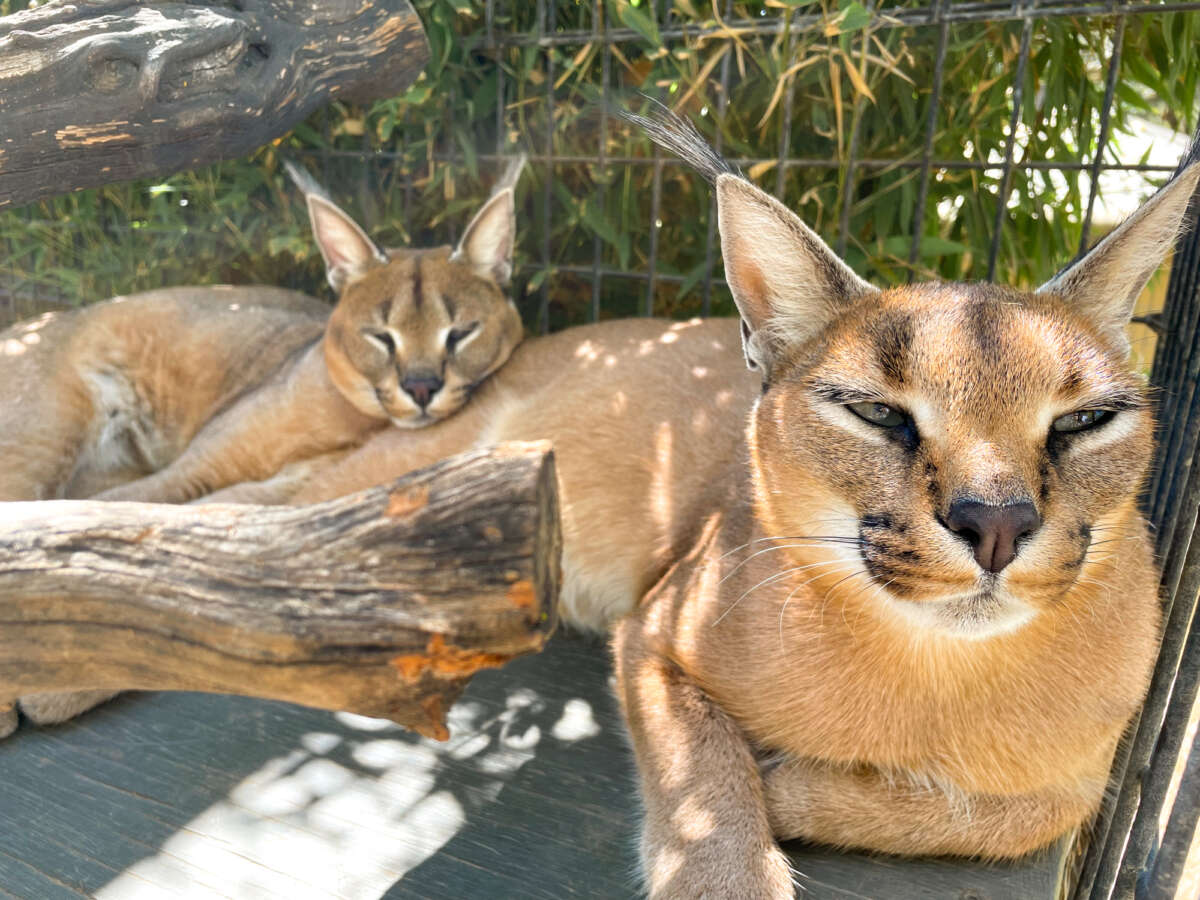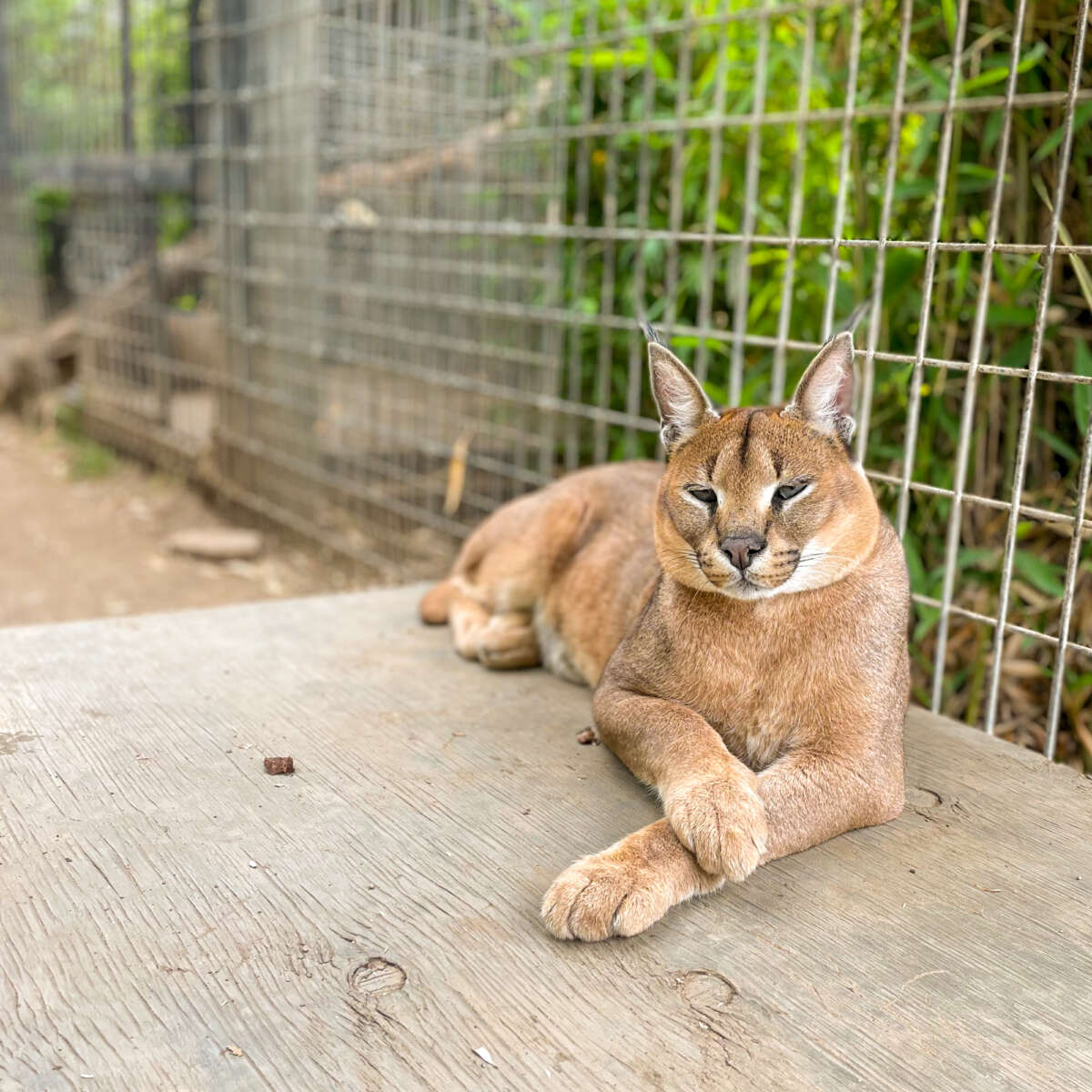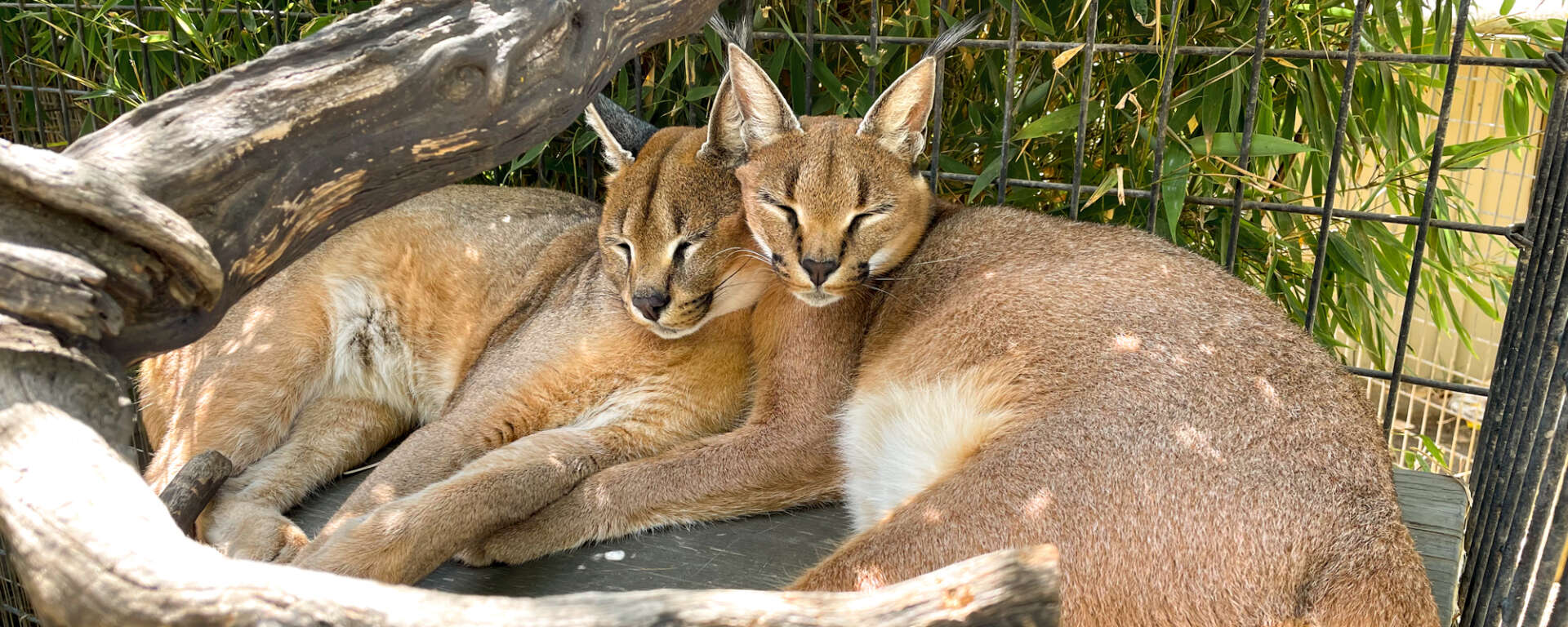Description
Caracals are medium-sized cats with a primarily reddish-brown coat and a white underside. They have distinct black markings across their faces and accentuated pointed ears that are black on the back with black tufts at their ends. The exact use of these tufts is unknown, but hypotheses include aiding hearing by funneling sound vibrations into the ear and aiding in the ear-based non-verbal communication that caracals engage in with each other. As well as long ears, the Caracal has disproportionately long legs—most notably in the hind limbs. The Caracal exhibits a relatively short tail, which is thought to aid in balance when jumping for or pouncing on prey.
Cover photo: Adult male and female caracals by Julia Hartlage
Classification
- Overview
- Caracals are mammals in the felid, or cat family. Their closest relatives are the African golden cat and the serval. The African golden cat inhabits the equatorial rainforest regions of central, western Africa—one of the few areas in Africa that caracals avoid. This would suggest that the ancestor of both caracals and African golden cats were under significantly different environmental pressures in these different regions and adapted accordingly, leading to a lack of interbreeding as their morphology and behavior differed more and more over time. Eventually, one species became two.
- Class
- Mammalia
- Order
- Carnivora
- Family
- Felidae
- Genus
- Caracal
- Species
- C. caracal
Key Facts
- Conservation Status
- Least Concern
- Lifespan
- ~12 years in the wild; up to 20 years under human care
- Weight
- 17 – 42 lb (~8 – 19 kg)
The IUCN Red List describes the caracal as a species of Least Concern in the majority of its range. However, populations are declining in areas of North Africa and throughout its Asian ranges. The greatest threats to the Caracal are habitat loss and their treatment as pests in ranching communities. There has not been a total population estimate made of caracals in the wild.
Social Life
Primarily solitary animals, male and female caracals occasionally have overlapping home ranges but only interact while courting and mating. Female home ranges do not typically overlap one another. Caracals are often said to be nocturnal but have been witnessed hunting during the day at times of cooler weather. Thus, their activity patterns seem to be dictated more by temperature than by time of day. During their active and inactive periods these cats are most often found on the ground living a terrestrial lifestyle though they can also demonstrate impressive climbing skills when being chased by larger predators. Despite their smaller stature, caracals present a tenacious attitude and have been known to chase off predators that more than double their size.
Habitat and Range
Caracals are widespread throughout Africa; limited only by the central Saharan and deep equatorial regions. They are also know to range throughout Central Asia, Southwest Asia, and into India, though these populations face more threats and are declining.
The habitat of the caracal can be diverse and reflects a generalized, opportunistic lifestyle. They seem to prefer semi-desert to relatively open grasslands and scrublands but are also known in moist woodlands and thickets and even into evergreen/montane forests, though this is more rare. These cats are also, though uncommon, effective predators in the Atlas Mountains and into the Ethiopian Highlands. The range and habitat of the caracal often overlaps with the range of the cheetah and the serval, though of these 3 cats, caracals are thought to be the most able to withstand more arid conditions.
Diet
Hunting often by the cover of low brush the caracal will pursue a wide variety of prey. Typically hunting small mammals (i.e. cape ground squirrels, Hyraxes), small monkeys and antelope are also common targets. With their tenacious attitude, caracals are even known to take prey 2-3 times their size, though this is not common. Though there have been accounts of these cats feeding on larger prey (e.g. Ostrich), caracals are well known scavengers and are unlikely to pursue such animals. Whereas mammals make up a majority of the diet, caracals also hunt small birds (guinea hens, francolins, etc.), reptiles, invertebrates, fish, and occasionally plant matter.
Predators
Though they do not tend to have common predators, both spotted hyenas and African lions have been known to prey on caracals.
Reproduction
Sexual maturity: Reach maturity at ~7 – 10 months; begin breeding around ~14 – 15 months
Mating Season: Opportunistic, usually correlated with resource abundance
Birth Season: Year-round
Gestation: 68 – 81 days
No. of Young: 1 – 6 per litter
Females have litters once a year despite their quick gestation. This is due to the degree of parental investment—females often stay with their young for a subsequent 5-6 months. Males take no part in infant rearing.
- Information
-
Description
Caracals are medium-sized cats with a primarily reddish-brown coat and a white underside. They have distinct black markings across their faces and accentuated pointed ears that are black on the back with black tufts at their ends. The exact use of these tufts is unknown, but hypotheses include aiding hearing by funneling sound vibrations into the ear and aiding in the ear-based non-verbal communication that caracals engage in with each other. As well as long ears, the Caracal has disproportionately long legs—most notably in the hind limbs. The Caracal exhibits a relatively short tail, which is thought to aid in balance when jumping for or pouncing on prey.
Cover photo: Adult male and female caracals by Julia Hartlage
Classification
- Overview
- Caracals are mammals in the felid, or cat family. Their closest relatives are the African golden cat and the serval. The African golden cat inhabits the equatorial rainforest regions of central, western Africa—one of the few areas in Africa that caracals avoid. This would suggest that the ancestor of both caracals and African golden cats were under significantly different environmental pressures in these different regions and adapted accordingly, leading to a lack of interbreeding as their morphology and behavior differed more and more over time. Eventually, one species became two.
- Class
- Mammalia
- Order
- Carnivora
- Family
- Felidae
- Genus
- Caracal
- Species
- C. caracal
Key Facts
- Conservation Status
- Least Concern
- Lifespan
- ~12 years in the wild; up to 20 years under human care
- Weight
- 17 – 42 lb (~8 – 19 kg)
- Conservation
The IUCN Red List describes the caracal as a species of Least Concern in the majority of its range. However, populations are declining in areas of North Africa and throughout its Asian ranges. The greatest threats to the Caracal are habitat loss and their treatment as pests in ranching communities. There has not been a total population estimate made of caracals in the wild.
- Lifestyle
Social Life
Primarily solitary animals, male and female caracals occasionally have overlapping home ranges but only interact while courting and mating. Female home ranges do not typically overlap one another. Caracals are often said to be nocturnal but have been witnessed hunting during the day at times of cooler weather. Thus, their activity patterns seem to be dictated more by temperature than by time of day. During their active and inactive periods these cats are most often found on the ground living a terrestrial lifestyle though they can also demonstrate impressive climbing skills when being chased by larger predators. Despite their smaller stature, caracals present a tenacious attitude and have been known to chase off predators that more than double their size.Habitat and Range
Caracals are widespread throughout Africa; limited only by the central Saharan and deep equatorial regions. They are also know to range throughout Central Asia, Southwest Asia, and into India, though these populations face more threats and are declining.The habitat of the caracal can be diverse and reflects a generalized, opportunistic lifestyle. They seem to prefer semi-desert to relatively open grasslands and scrublands but are also known in moist woodlands and thickets and even into evergreen/montane forests, though this is more rare. These cats are also, though uncommon, effective predators in the Atlas Mountains and into the Ethiopian Highlands. The range and habitat of the caracal often overlaps with the range of the cheetah and the serval, though of these 3 cats, caracals are thought to be the most able to withstand more arid conditions.
Diet
Hunting often by the cover of low brush the caracal will pursue a wide variety of prey. Typically hunting small mammals (i.e. cape ground squirrels, Hyraxes), small monkeys and antelope are also common targets. With their tenacious attitude, caracals are even known to take prey 2-3 times their size, though this is not common. Though there have been accounts of these cats feeding on larger prey (e.g. Ostrich), caracals are well known scavengers and are unlikely to pursue such animals. Whereas mammals make up a majority of the diet, caracals also hunt small birds (guinea hens, francolins, etc.), reptiles, invertebrates, fish, and occasionally plant matter.Predators
Though they do not tend to have common predators, both spotted hyenas and African lions have been known to prey on caracals.Reproduction
Sexual maturity: Reach maturity at ~7 – 10 months; begin breeding around ~14 – 15 months
Mating Season: Opportunistic, usually correlated with resource abundance
Birth Season: Year-round
Gestation: 68 – 81 days
No. of Young: 1 – 6 per litter
Females have litters once a year despite their quick gestation. This is due to the degree of parental investment—females often stay with their young for a subsequent 5-6 months. Males take no part in infant rearing.

Adult male & female caracals by Julia Hartlage

Adult male caracal by Julia Hartlage

